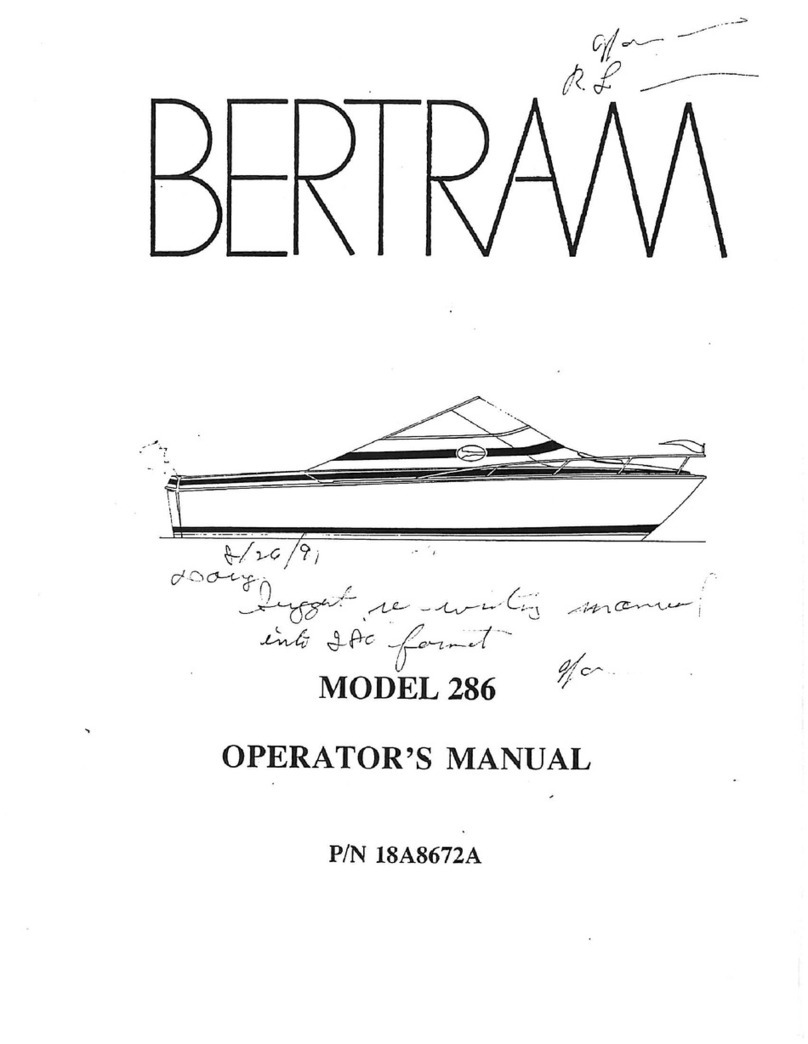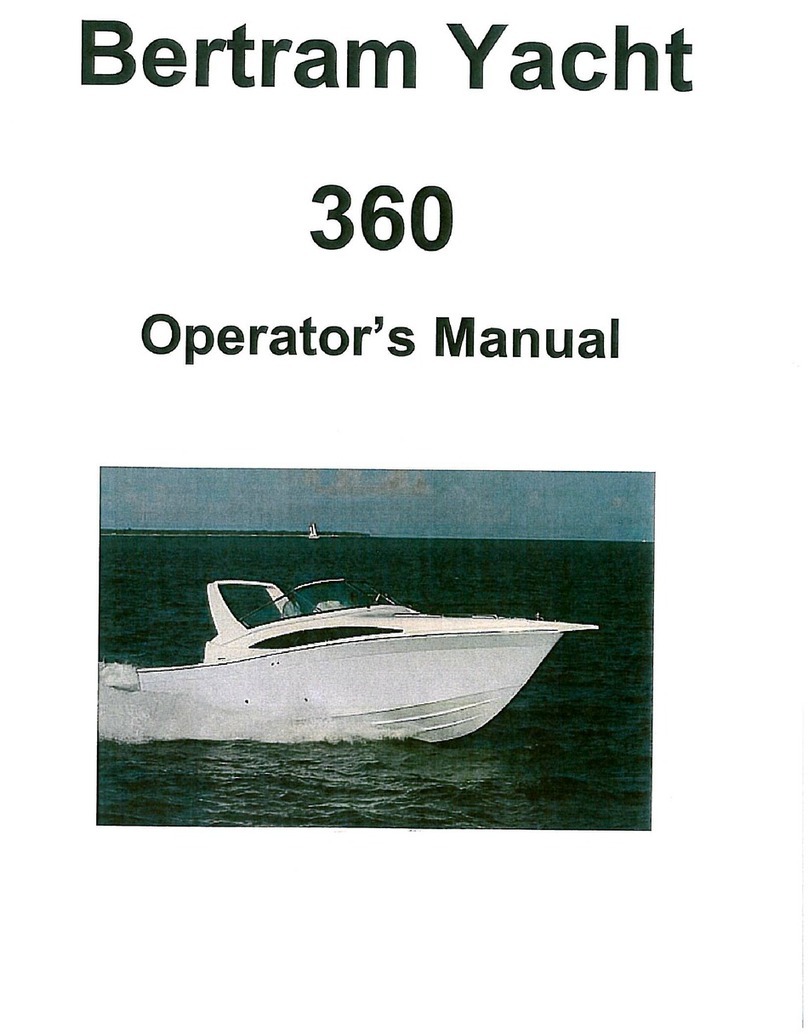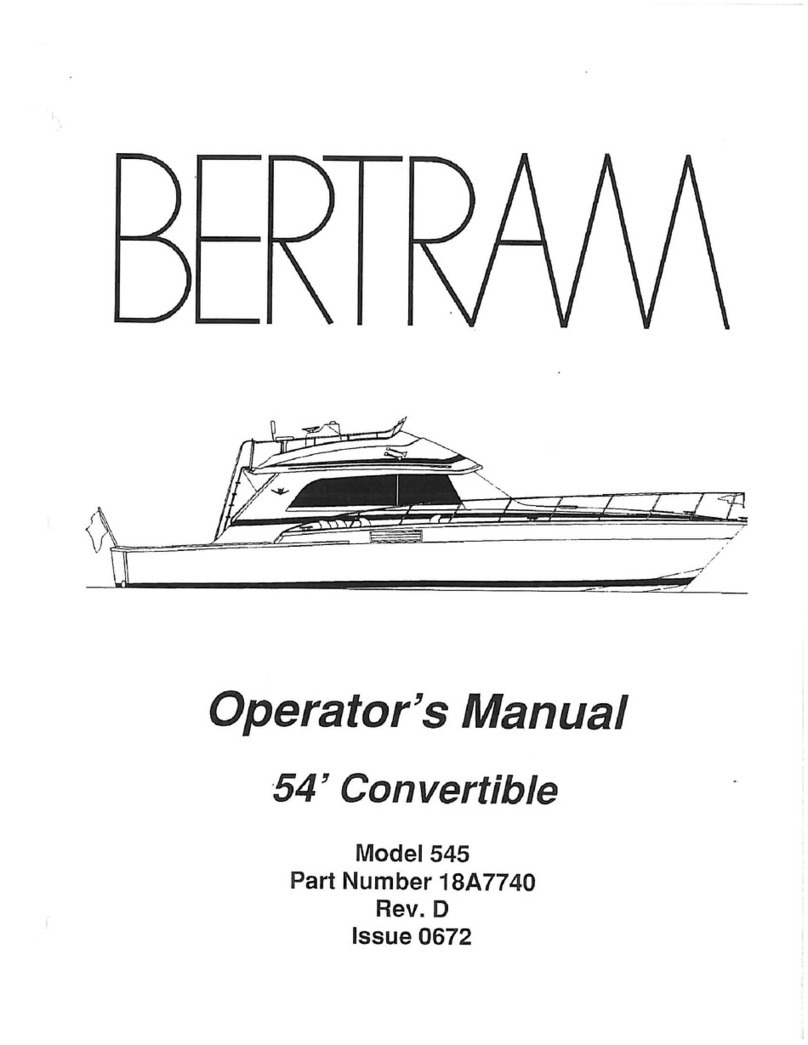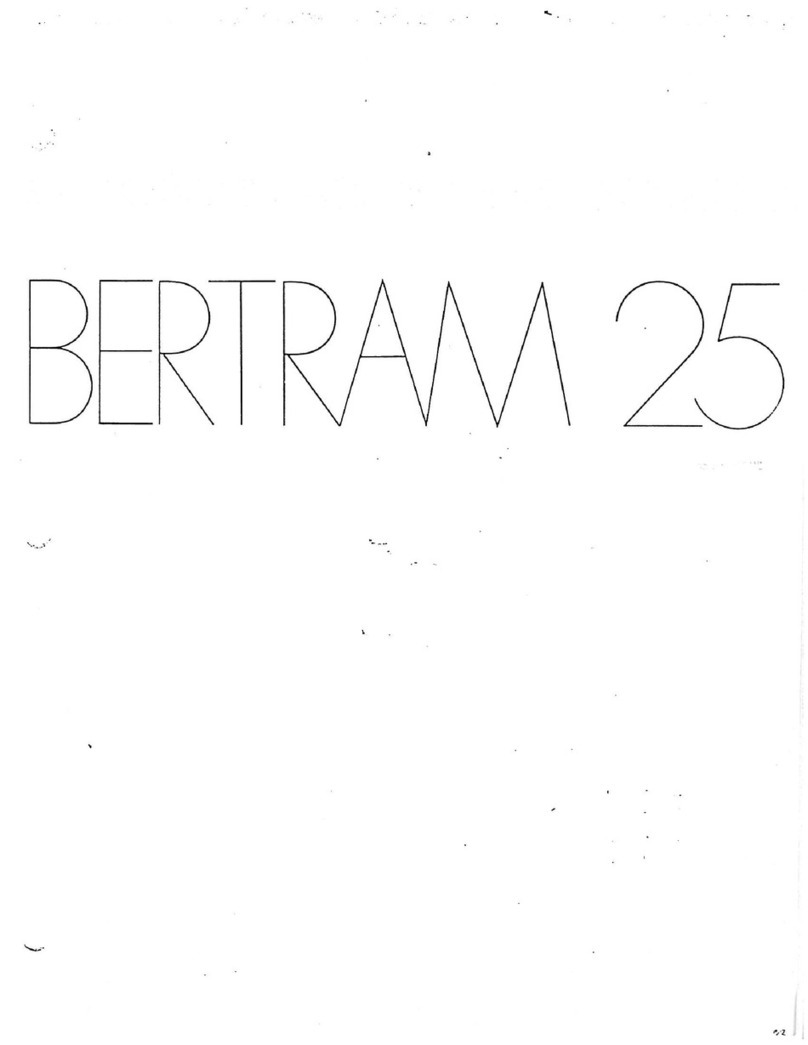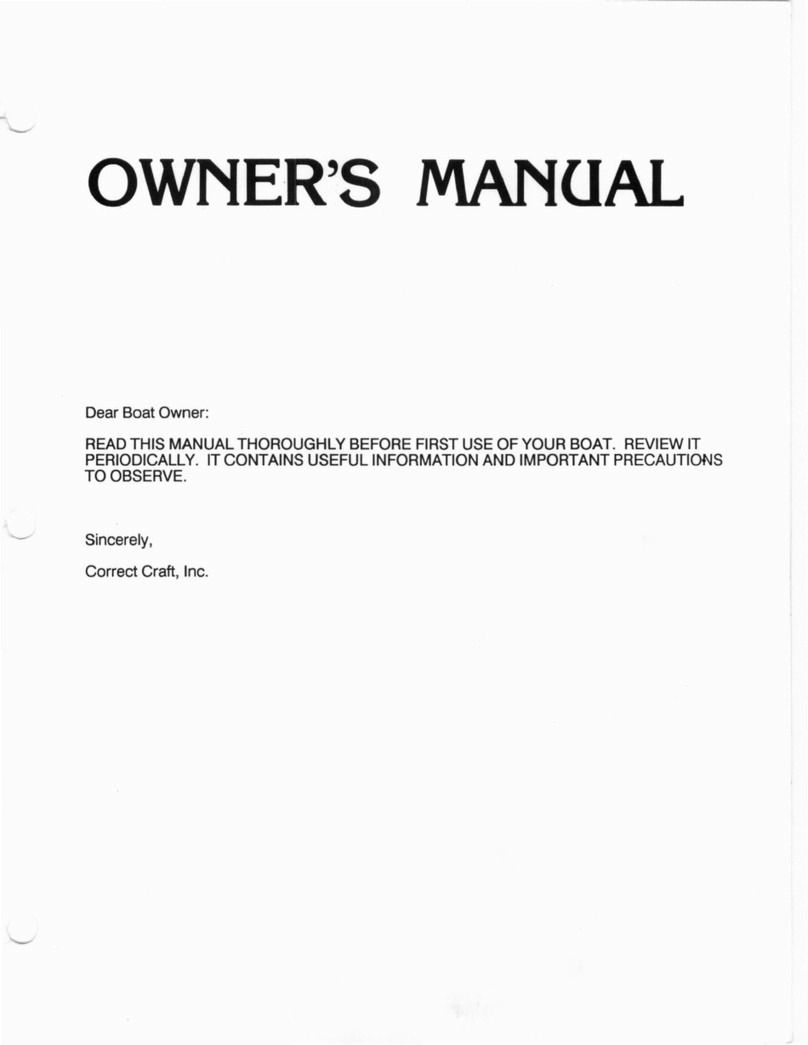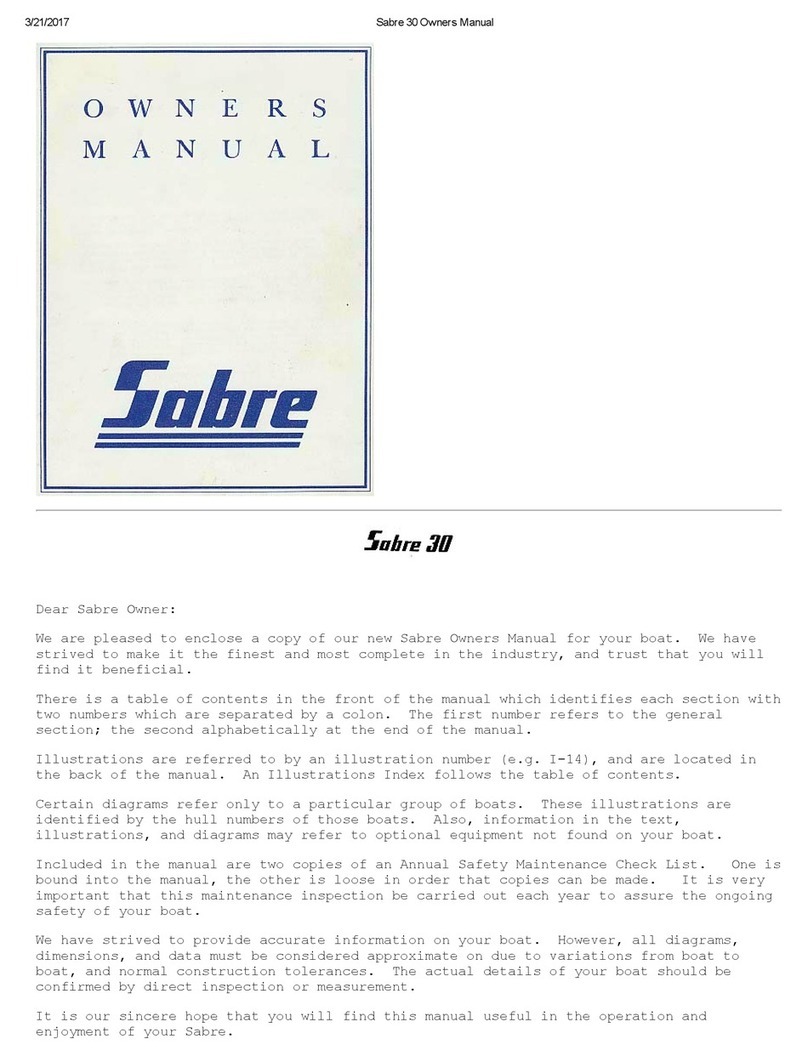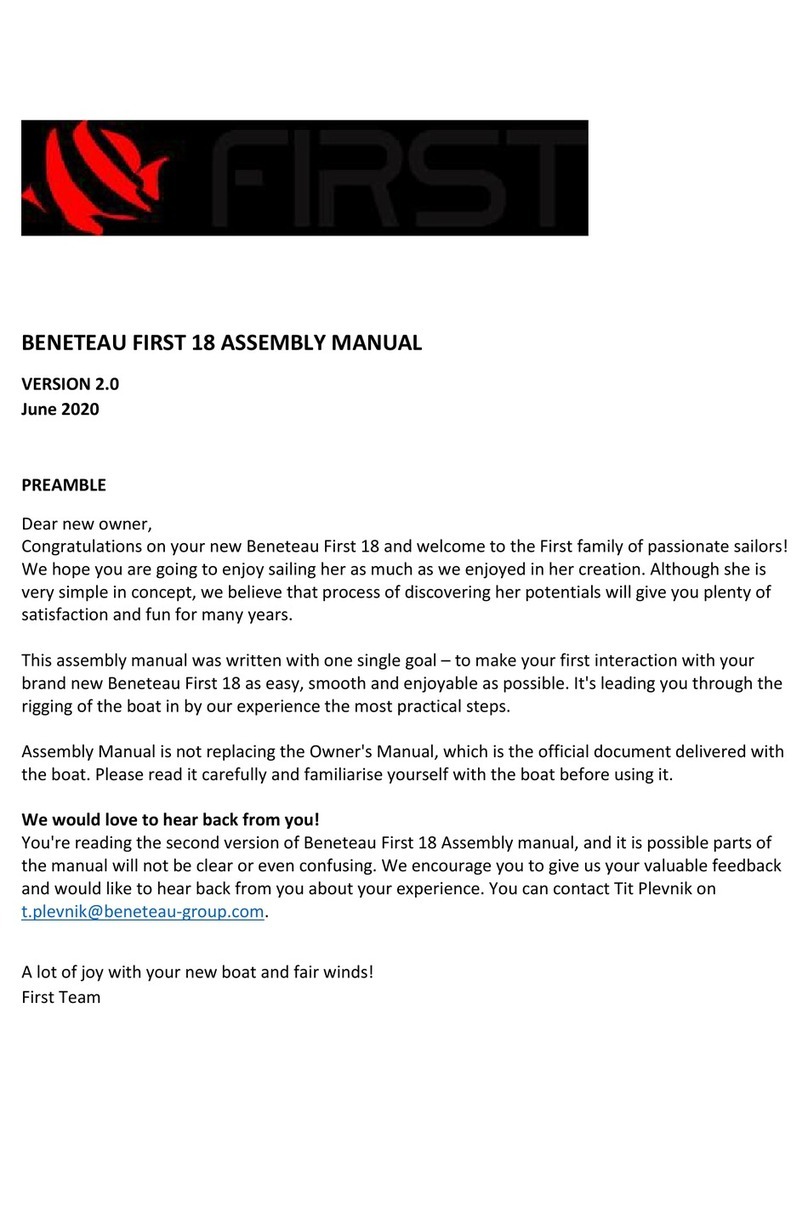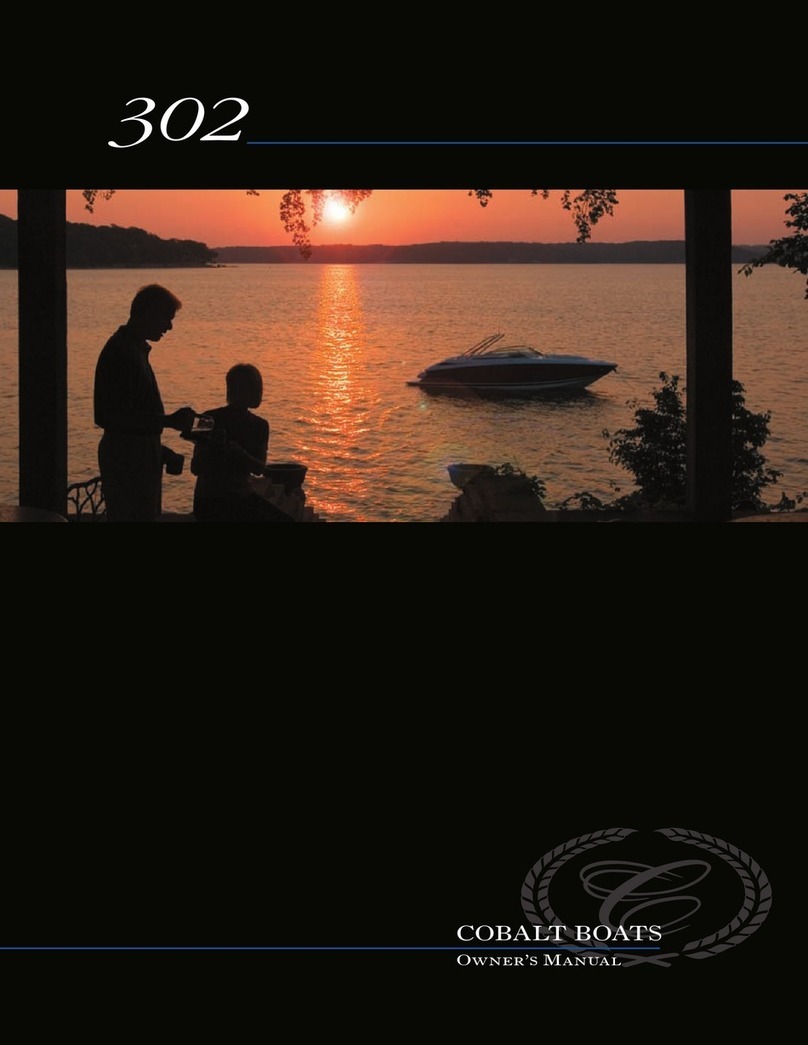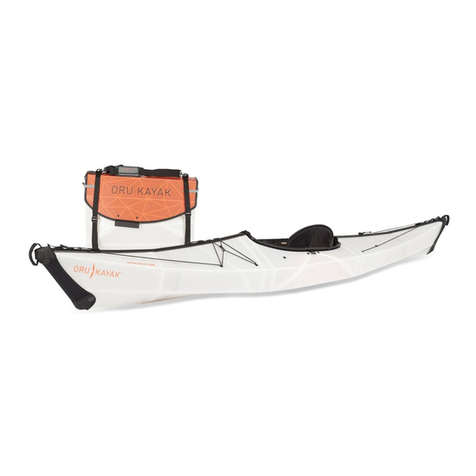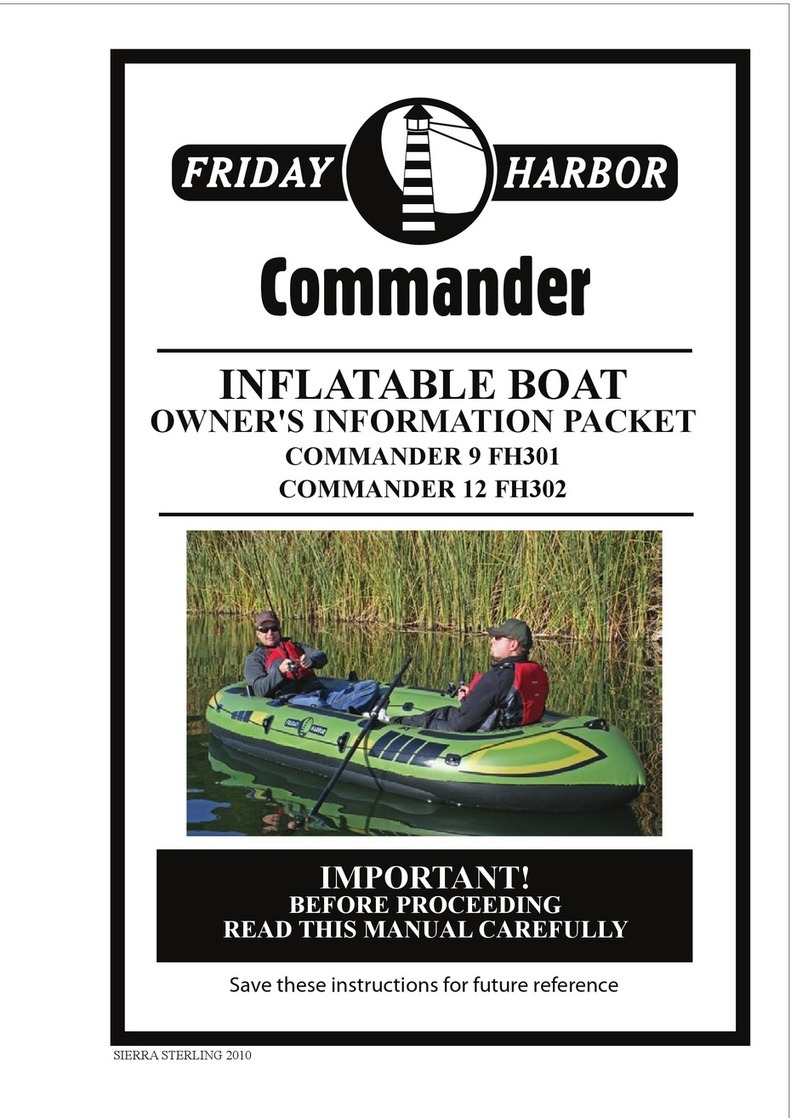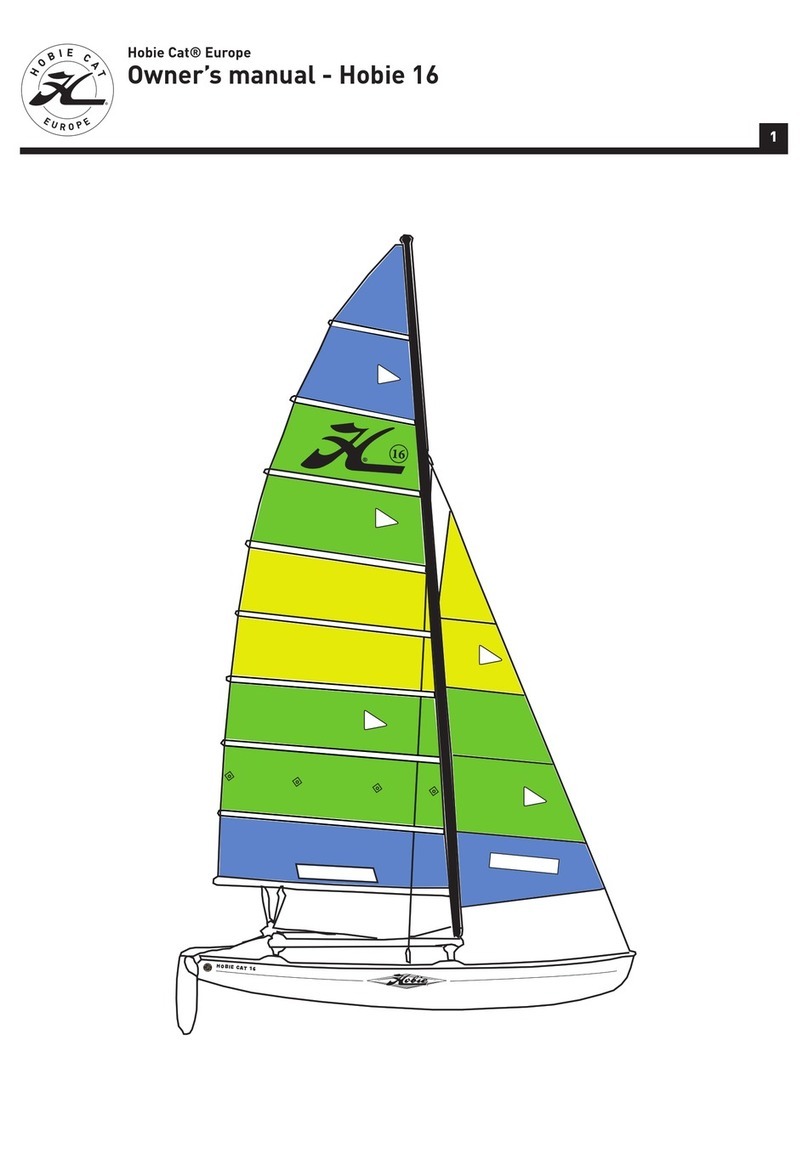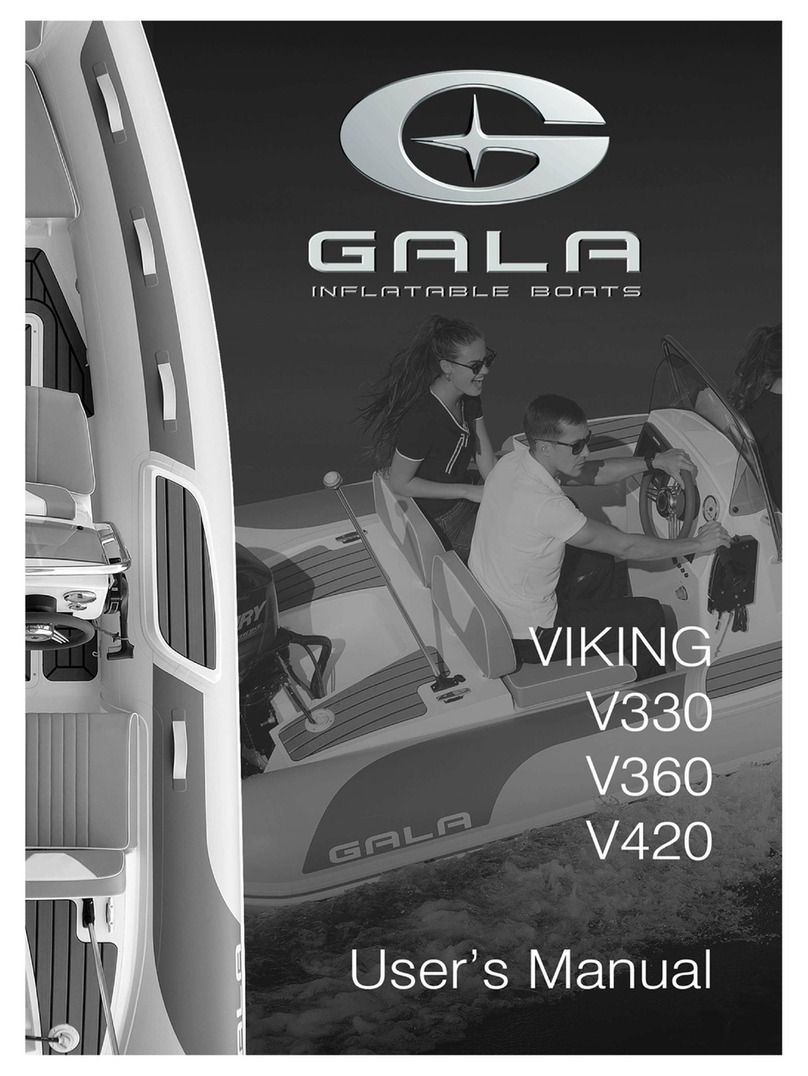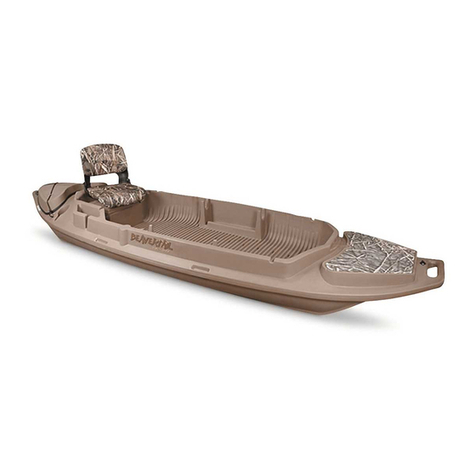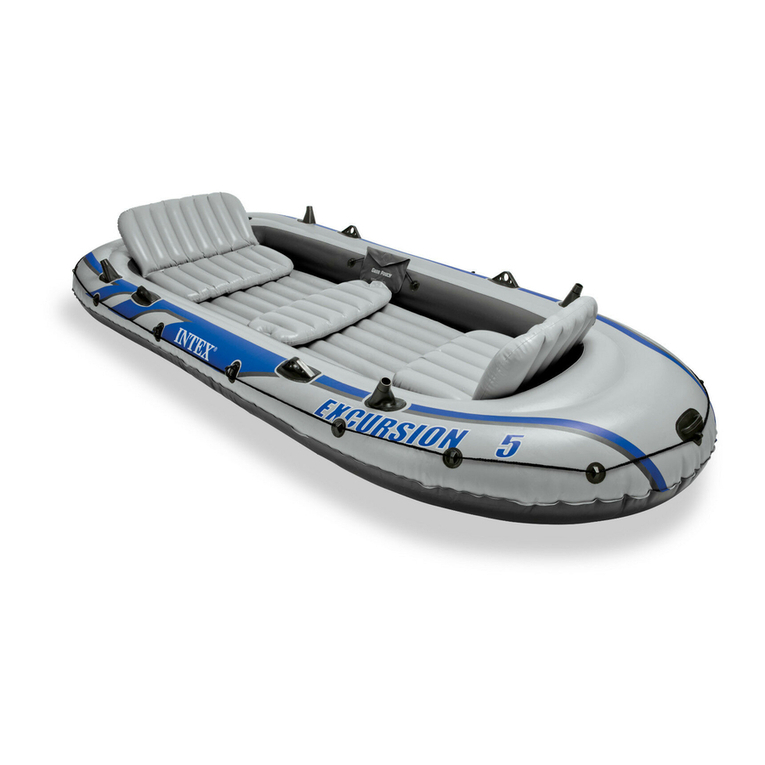Bertram 285 User manual

OPERATOR'S MANUAL
PIN 18681
ISSUE 2508C

REVISION
AND
EFFECTIVITY
PAGE
REVISION EFFECTIVITY
HULL
NUMBER
CHANGES
:
====~~====l=========================:================
==========1
o
501
AND
SUBSEQUENT ORIGINAL ISSUE
A
January
1987
GENERAL
CHANGES
B
July
1988
GENERAL
UPDATE
~
-
",.

A
WORD
OF
WELCOME
We
are
pleased
that
you
have
chosen
a
Bertram,
and
know
that
its
unique
design
will
give
you
outstanding
performance
and
many
years
of
boating
pleasure.
Your
Bertram
is
built
with
fine,
modern
materials
and
is
manufactured
to
Bertram's
demanding
quality
standards.
It
comes
to
you
as
a
factory-tested
and
inspected
boat.
As
durable
as
its
construction
is,
your
Bertram
will
benefit
by
reasonable
care.
And,
as
is
always
true
with
things
mechanical,
maintenance,
adjustments,
or
repairs
may
be
required
from
time-
to-time
for
certain
components.
Thus,
this
Operator's
Manual,
containing
a
wealth
of
detailed
information,
has
been
prepared
for
your
particular
model
as
a
guide
for
keeping
it
in
good
operating
condition.
To
fully
enjoy
your
Bertram,
you
should
understand
it
completely.
To
this
end,
we
suggest
that
.
you
read
this
manual
thoroughly.
If
any
points
arise
that
you
do
not
completely
understand,
your
Bertram
dealer
will
be
glad
to
assist
you.
, When
your
boat
requires
service,
contact
your
Bertram
dealer.
He
has
been
factory
trained
to
help
you
and
our
factory
service
representatives
are
available
to
help
him
if
need
be.
We
wish
you
many
y
ears
of
pleasurable
yachting
on
your
new
Bertrarr
- i

PREFACE
This
manual
is
divided
into
sections.
Except
for
Section
A,
The
Table
of
Contents,
and
Section
B,
Vessel
Technical
Data,
each
section
covers
a
specific
system·
or
systems.
Included
in
this
manual
are
the
recommended
preventative
maintenance
schedules.
In
addition
to
this
manual,
you
will
find
the
following
two
packets
of
information
:
1.
The
12
Vdc
and
the
120
Vac
systems
wiring
diagrams
and
the
basic
mechanical
drawings.
2.
The
users
manuals
and
operating
instructions
supplied
by
the
manufacturers
of
the
major
mechanical,
electrical,
and
comfort
equipment
components.
These
drawings
and
manuals
."~.~ll
not
only
help
you
to
get
a
better
understanding
of
the
equipment
·
and
systems
on
your
Bertram
and
how
they
operate,
but
they
will
be
invaluable
to
the
technicians
that
service
your
Bertram.,
Each
appliance
and
major
piece
of
on-board
equipment
is
cov~red
by
manufacturers'
operating
and
maintenance
manuals.
However,
some
on-board
systems
and
equipment
need
scheduled
preventative
maintenance
which
is
not
discussed
in
these
manuals.
This
scheduled
maintenance
is
discussed
in
Section,G,
"MAINTENANCE"
of
this
manual.
Section
G
also
includes
recommended
trouble-
shooting
techniques,
Bertram
recommended
storage
and
refloating
procedures,
and
other
special
maintenance
procedures.
-
ii
-

HISTORY
The
Bertram
Yacht
Company
is
widely
accepted
through
out
the
boating
fraternity
as
the
number
one
pleasure
boat
manufacturer
in
the
world.
The
history
of
Bertram
Yacht
dates
back
to
1960,
although
the
inspiration
for
the
Bertram
yacht
line
actually
started
in
July
of
1958
when
Richard
Bertram,
a
highly
successful
'
Miami
yacht
broker,
watched
a
24-foot
tender
designed
by
C.
Raymond
Hunt
ferrying
crews
and
sails
around
the
harbor
during
the
trials
for
the
America's
Cup
Race.
Watching
that
performance,
Richard
Bertram
was
very
impressed
with
the
smooth
ride,
the
ease
of
maneuvering,
and
the
stability
that
this
24-foot
"Hunter"
demonstrated
in
the
heavy
seas.
This
radical
design
was
a
full-length,
deep
"V"
hull
and
it
was
a
major
break
through
in
boat
design.
Richard
Bertram
recognized
this
and
commissioned
Hunt
to
design
and
build
a
similarly
shaped
hull
design
in
the
form
of
a
wooden
31-footer
which
was
to
be
completed
in
1960.
Even
though
this
31-footer
was
never
intended
to
be
an
ocean
racing
boat,
she
performed
so
well
on
her
shakedown
cruise
that
Bertram
entered
her
in
the
1960
Miami
to
Nassau
Ocean
Powerboat
Race.
With
Richard
Bertram
as
the
pilot
and
veteran
race
boat
driver
Sam
Griffith
as
crew,
"Moppie"
,
named
after
Mrs.
Bertram,
won
this
race
in
record
time
under
boating
conditions
that
were
so
severe
that
only
one
other
boat
even
finished
the
race
that
day.
This
surprising
victory
demonstrated
to
an
amazed
boating
public
that
a
deep
"V"
hull
design
could
plane
and
still
maintain
-
iii
-

high
speeds
in
rough
seas.
Richard
Bertram
recognized
the
possi-
bilities
of
this
Hunt
designed
hull
and
Bertram
put
his
resources
and
reputation
behind
the
newly
formed
Bertram
Yacht
Company.
The
new
hull
design
was
just
the
beginning
of
a
long
list
of
innovative
designs
and
materials.
At
a
time
when
wood,
steel,
and
aluminum
dominated
the
boat
building
industry,
Richard
Bertram
used
the
hull
of
his
victorious
31-footer
as
a
plug
to
construct
a
mold
to
build
his
new
boat
from
fiber
reinforced
plastic
(FRP)
a
relatively
new
material
to
the
pleasure
boating
industry.
This
first
model
31-footer
was
the
sensation
of
the
1961
New
York
National
Boat
Show.
A
year's
production
was
sold
out
in
advance.
With
manufacturing
of
the
31-footer
well
under
way
and
several
additional
models
on
the
drawing
boards,
the
Bertram
Yacht
Company
became
a
division
of
the
Nautec
Corporation.
In
November
of
1962,
a
new
manufacturini"facility
was
completed
at
Bertram's
present
location,
about
one
mile
east
of
the
Miami
International
Airport.
In
1968,
the
California
based
Whittaker
Corporation,
with
interests
in
metals,
chemicals,
science,
technology,
and
recreational
products,
acquired
Bertram
Yacht.
With
Whittaker's
support,
Bertram
was
able
to
expand
and
become
a
leader
in
the
pleasure
boat
industry.
In
March
of
1985,
Whittaker
sold
their
interest
in
Bertram
Yacht
along
with
other
marine
related
manufacturing
operations.
Today,
Bertram
Yacht
is
a
division
of
Bertram-Trojan,
Inc.
and
manufactures
models
from
28
to
54
feet
in
length.
-
iv
-

,
Since
1961,
most
of
Bertram's
boat
construction
experience
has
been
in
making
the
highest
quality
recreational
power
boats.
However,
Bertram
has
also
built
a
variety
of
commercial
and
military
power
boats
for
many
foreign
and
.
domestic
customers.
Bertram
power
boats
are
a
product
of
offshore
power
boat
racing
and
Bertram
has
continued
its
dedication
to
high
performance
products.
While
not
currently
active
on
the
racing
circuit,
this
company
has
built
racing
hulls
for
others.
The
Bertram
philoso-
phy
is
that
this
continued
exposure
to
racing
has
been
one
way
to
maintain
the
enthusiasm
and
motivation
in
the
design
areas
of
hull
performance.
The
results
of
the
continuing
design
research,
material
applications
research,
and
construction
methods
research
have
been
applied
to
Bertram's
primary
products.
One
of
the
engineering
and
"design
areas
where
this
basically
conservative
engineering
oriented
company
has
led
the
way
was
as
one
of
the
early
users
of
balsa
core
construction
in
decks
and
superstructures
beginning
in
1965.
Bertram
was
also
one
of
the
first
in
this
industry
to
use
aluminum
decks
and
superstructure
on
fiberglass
boats.
This
was
used
on
the
58-foot
yacht
and
on
commercial
v
essels.
Bertram
was
also
first
in
the
design
and
use
of
fiberglass
fuel
tanks
and
was
also
the
first
production
boat
company
to
make
its
own
aluminum
window
frames.
- v -

FOREWORD
This
manual
is
not
intended
to
replace
years
ot
boating
experience
or
even
one
of
the
several
excellent
sate
boating
classes
taught
by
the
U.
S.
Coast
Guard
Auxiliary
and
the
U.
S.
Power
Squadron.
We
included
some
material
relative
to
certain
aspects
of
safe
boating
that
a
careful
boat
operator
should
be
,aware
of.
WARNINGS, CAUTIONS,
AND
NOTES
Throughout
this
manual
you
will
find
special
information
in
the
form
ot
warnings,
cautions,
and
notes
that
are
intended
to
alert
you
to
possible
dangers
to
yourself,
the
crew
or
passengers,
and/or
to
your
vessel.
Read
these
special
information
items
carefully.
The
mere
existence
of
a
warning
or
a
caution
note
wi
thin
a
box
of
asteri.:s.~s
will
not
by
i
tselt
eliminate
the
dangers.
Your
close
attention
to
'
the
instructions,
plus
basic
"good
seamanship"
are
the
major
accident
prevention
measures.
~*****************~******************************
•
WARNING:
FAILURE
TO
HEED
A
WARNING
MAY
RESULT
IN
DEATH
OR
SERIOUS
INJURY.
•
*************************************************
*************************************************
•
•
•
•
•
CAUTION
Failure
to
heed
a CAUTION'
may
result
in
injury
and/or
damage
to
the
vessel.
vi
•
*
*
*
*
•
•

NOTE:
Notes
are
in
boldface
.
type
and
are
intended
to
stress
important
pieces
of
information.
We
wish
you
many
years
of
pleasurable
yachting
on
your
new
Bertram.
GETTING ACQUAINTED
WITH
YOUR
BERTRAM
MODEL
285
FLYBRIDGE CRUISER
THE
COCKPIT
The
three
hatches
in
the
cockpit
sole
at
the
stern
provide
access
to
the
aft
bilge.
The
aft
bilge
contains
the
rudder
post,
stuffing
boxes,
and
the
components
of
the
hydraulic
steering
system.
The
optional
aft
bilge
pump
and
its
automatic
float
switch
and
the
bilge
flood
alarm
switch
(mounted
higher
than
the
bilge
pump)
are
accessible
through
the
center
hatch,
as
is
the
fuel
gauge
sender,
fuel
supply
fittings,
and
the
trim
tab
pump.
A
port
and
starboard
hatch
aft
-
of
the
motor
boxes
provide
access
to
the
propeller
shaft
log
stuffing
boxes
and
their
sprayshields.
On
each
side
of
the
cockpit
is
a
storage
space
with
a
sliding
cover.
The
shoreline
is
permanently
connected
in
the
port
side
storage
locker.
THE
ENGINE
COMPARTMENT
Over
e
ach
engine
is
a
hinged
hatch
for
access
to
the
engines
and
the
spaces
outboard
of
each
engine
.
In
addition
to
the
hatch
over
each
engine.
an
access
hatch
is
provided
between
the
engines.
-
vii
-

The
center
hatch
provides
access
to
the
battery
disconnect
switches
and
fuse
panel
mounted
on
the
forward
engine-compartment
bulkhead.
The
optional
air
conditioning
system
sea-water
cooled
condenser
is
in
the
engine-compartment
on
the
port
side.
The
Ale
seacock,
strainer
and
pump
are
just
aft
of
the
forward
engine-
compartment
bulkhead.
The
engine-compartment
sump
pump,
its
automatic
float
switch,
and
the
midship
bilge
flood
alarm
switch
are
located
at
the
forward
end
of
the
engine-compartment.
There
are
also
port
and
starboard
fuel
valves
to
control
the
fuel
supply
to
their
respective
engines
.
The
seacocks
and
seawater
strainers
for
each
engine
and
the
garboard
hull
drain
are
in
the
aft
end
of
the
engine-
compartment.
The
fixed
Halon
fire
extingu
"
isher
cylinder
is
mounted
on
the
aft
.-
" "I·
engine-compartment
bulkhead.
The
supply
seacock
for
the
toilet
system
is
located
under
the
forward
end
of
the
starboard
engine.
The
head
exhaust
blower
is
mounted
on
the
bulkhead
forward
of
the
port
engine.
Outboard
of
the
engines
are
the
port
and
starboard
exhaust
blowers
which
ventilate
the
bilge
area.
The
port
and
starboard
batteries
are
located
outboard
of
the
port
engine.
They
may
be
relocated
to
provide
better
weight
distribution,
depending
on
the
options
selected.
The
optional
converter
(battery
charger)
is
located
outboard
of
the
starboard
engine.
The
toilet
holding
tank
is
located
outboard
of
the
port
engine.
The
"Y"
control
v
alve
that
allows
you
to
select
-
viii
-

,
where
the
toilet
empties,
(the
holding
tank
or
directly
overboard)
and
the
manual
overboard
discharge
pump
are
forward
of
the
holding
tank
and
accessible
through
the
port
engine
hatch.
For
additional
information
see
"Toilets"
in
the
Mechanical
Section
of
this
manual.
THE
FLYBRIDGE
CONTROL
STATION
The
flybridge
control
station
has
a
helm
seat
adjustable
for
height
facing
the
control
console
with
its
built-in
footrest
.
The
engine
gauge
panel,
twin
tachometers,
and
the
system
control
switches
are
mounted
on
the
flybridge
control
console
forward
of
the
helm.
The
throttles
and
gear
shifts
are
on
each
side
of
the
helm.
The
trim
tab
controls
and
the
alarm
panel
are
mounted
on
the
control
panel
as
is
the
Halon
fire
extinguisher
monitor
panel.
Inside
a
storage
sp~~e,
in
the
console,
is
the
12
Vdc
"electronics"
distribution
panel
that
powers
the
communications
and
navigation
equipment
that
you
choose
to
have
on
y
our
vessel.
THE
CABIN INTERIOR
Forward
·
of
the
lower
step
with
its
built-in
storage
space
are
two
bilge
pump
access
hatches
.
The
shower
and
air
conditioner
sump
pump
is
under
the
cabin
sole
between
the
water
tanks
and
is
accessible
through
the
aft
cabin
hatch.
The
forward
bilge
pump
and
its
automatic
float
switch
and
the
bilge
flood
alarm
switch
(mounted
higher)
are
accessible
through
the
forward
bilge
access
hatch.
-
ix
-

The
fresh
water
tank
is
located
just
forward
of
the
forward
engine-compartment
bulkhead.
The
fresh
water
system
pump
is
located
in
a
locker
aft
of
the
"Vee
"
berth
bulkhead
on
the
port
side.
Water
is
heated
by
a
120
Vac
shore-power,
water
heater
enclosed
in
the
galley
cabinet
below
the
stove
area.
If
your
boat
has
the
optional
air
conditioning
system,
the
~vaporator
and
controls
are
built
into
the
deckhouse
overhead.
The
dinette
table
has
a ·
movable
leg
that
permits
it
to
be
lo
w
ered,
and
a
filler
cushion
is
provided
to
convert
it
to
a
double
bed.
Access
to
the
rope
locker
is
provided
by
doors
on
the
forward
storage
locker.
120
VAC
outlets
are
provided
in
the
galley,
the
head
(toilet),
the
dinette,
and
the
face
of
the
starboard
"vee"
berth
.
The
12
Vdc
distribution
panel
is
located,
to
starboard,
in
the
Ilvee
ll
berth
area.
The
120
Vac
distribution
panel
is
located
in
the
aft
dinette
seat,
facing
inboard.
- x -

TABLE
OF
CONTENTS.
FRONT
MATTER
Dealer
Evaluation
Card
Title
Page
Revision
Page
Preface
Foreword
A.
CONTENTS
SECTION
Table
of
Contents
.....
.
..
.....
. .
..
....
......................
A-1
B.
TECHNICAL
DATA
SECTION
A.
VESSEL TECHNICAL
DATA
.
.............
......
........
..
. . . .
B-1
B.
MAIN
ENGINES
....
..
...
...
...
.
...
.
................
.
......
B-2
C.
ENGINE
BATTERIES
.......................................
B-2
D.
PROPELLERS
...........
-:.:
...
..
_
..
....
_
..........
. . _
....
...
B-2
.-
" I
E.
PROPELLER SHAFTS
................................
..
....
..
B-3
F.
FUEL
REMAINING
IN
TANKS
............
..
. .
......
_
..
.....
..
B-3
-.
Table
B-1,
Fuel
Readings
Vs
Tank
Gallonage
.............
B-3
G.
VENTILATION
AND
EXHAUST
BLOWERS
..............
...
.....
..
B-3
H.
BILGE
AND
SUMP
PUMPS
...................................
B-4
I.
HOLDING
TANK
CAPACITY
.........
.
........................
B-4
J.
PERFORMANCE
CHARTS
............
......
.. ..
.
...
.
....
..
....
B-4
A-1

C.
CONTROLS
AND
INSTRUMENTS
SECTION
A.
SWITCHES
....
.
....
C-l
1.
Battery
Power
....
.
...............................
C-l
2.
Before
Starting
Engine
....
,
......................
C-l
3.
Starting
Engine
..
....
...........
.
...
.
.............
C-1
4.
Battery
Paralleling
Switch
........................
C-2
5.
After
Engine
Starts
..........................
..
...
C-2
6.
Stopping
Engine
....
....
.
..
.
.. ..
.
..................
C-2
7.
Accessory
Switches
..........
.
.................
'"
.C-3
B.
INSTRUMENTS
...........
....
.....................
...
.....
C-4
1.
The
Importance
of
Instruments
...............
.
.....
C-4
2.
Oil
Pressure
Gauge
................................
C-4
3.
Temperature
Gauge
............................
.
....
C-5
4.
Tachometer
..................
.
..
.
..................
C-5
5.
Hour
Meter
.................
..
..
.
.......
...
........
C-6
6.
Voltmeter
......
.
.....
.; . '
.......
..
.......•..
. .
..
. . .
C-6
7.
Fuel
Gauge
..................
...
..
.
..........
.'
.....
C-6
C.
ALARM
SYSTEMS . . . .
...
. '. . ' .'
.........................
...
. .
C-7
1.
::ngine
alarms
...
. .
...
..........................
.
..
C-7
2.
Bilge
Alarm
Switches
...
.....
...
.
.... ....
......
....
C-8
3.
Fire
Alarm
Switches
. .
.....
.
.......
.
...............
C-9
4.
Fire
and
Bilge
alarm
Lights
.............
...
.......
C-9
D.
MECHANICAL CONTROLS
...
.
..............
.
.......
. .
....
C-9
1 .
Engine
Speed
and
Marine
Gear
Controls....
. .
..
.
C-9
2.
Steering
System
...
...
. . . . .
..
. . . . . . . . .
..
. .
..
. . . . .
C-I0
3.
Trim
Tabs.........
. . .
..
.
....
..
.........
. . .
..
..
. .
C-I0
A-2

D. VESSEL OPERATIONS
AND
SAFETY
AFLOAT
A. VESSEL SAFETy
..
.....
..
.......
..
...
.
....
..
.....
.
.....
.
..
D-l
1.
Fueling
Instructions
.
.....
.
.....
....
......
......
..
D-l
2.
Before
Fueling
......
. :
............................
D-2
3.
After
Fueling
.....
...
....
...
.
.....
'
..
...
..
. .
...
.. ..
D-2
B.
CARBON
MONOXIDE
GAS
...
. .
..
.........
.
.......
..
....
. .
..
..
D-3
C.
THE
FISHING
TOWER
. .
......
....
. .
......
..
.........
..
.....
D-5
D.
WHEN
UNDERWAy
.................
; . . .
..
.....
.
...
.
.........
D-5
E.
PROPELLER
HAZARD
.
....
.....
..
...........
.
.....
.
..
.
..
...
.
D-6
F .
ALCOHOL
STOVE
FLARE-UP
...................
.
.......
. .
..
. .
D-7
G.
THE
FIRE
WARNING
AND
THE
FIRE
EXTINGUISHING SYSTEMS
....
D-7
1.
General
......................................
. .
...
D-7
2.
The
Fire
and
Bilge
Flood
Alarm
Systems
...
........
.
D-8
3.
The
Fixed
Fire
Extinguisher
Discharged
Moni
tor
System
..•
,'
..
' .
.............
..
..
...
..
......
..
D-9
4.
The
Portable
Fire
Exd.riguishers
...........
.
.......
D-9
5.
The
Halon
1301
Fixed
Fire
Extinguisher
System
.
...
D-ll
6.
System
Function.'
..
...
...............................
D-12
7.
After
the
Fixed
Fire
Extinguisher
System
Discharge
. .
...
.
..............
.
.....
.
......
:D-13
8.
'
Inspection
and
Restarting
Vessel
Systems
..
...
..
...
D-14
....
H.
THE
FIRE
FIGHTING
PLAN
........
..
...............
.
.......
D-15
I.
THE
FIRE
OR
EMERGENCY
EVACUATION
PLAN
.
...
.
...
......
.
..
.
D-16
J.
THE
USE
OF
PERSONAL
FLOATATION DEVICES
...
'. .
....
..
......
D-17
K.
THE
RING
BOUY
...
..
..
.
...
. .
...
.
..
'.
....
. .
...
...
. .
..
.
...
..
D-19
L.
RADIOS
AS
EMERGENCY
EQUIPMENT
..................
..
......
D-19
M.
MANEUVERING
.
.. ..
......
.
..
..
.........
.
...
...
....
...
.....
D-
19
A
-3

N. SINGLE ENGINE RUNNING
..
...
..
........
.....
..
0 0
••••
0 • • 0
••
0-20
O.
DAMAGED
UNDERWATER
EqUIPMENT
.............
.
.............
0-20
P.
VESSEL SPEED
..................
.
...
.......
.....
....
..
...
0-21
Q.
RUNNING
AGROUND
..................................
.
.....
0-22
R.
RECOMMENDATIONS
FOR
REFLOAT!NG VESSEL
.......
.. ..
.
......
0-23
S.
FLOTSAM
(Floating
Oebris)
............................
. .
0-25
T.
VIBRATIONS
....
..
.
...............
.................
.....
.
0-25
~.
TOWING
.................................................
D-25
1.
General
....
..........
..
..
.
.....
..
....
..
...
..
...
...
0-26
2.
Personal
Safety
....
. .
..
.
..
..................
.
.....
0-26
V.
NAVIGATION
and
RUNNING
LIGHTS
...............
. .
.........
0-27
1'1
• VISUAL
DISTRESS
SIGNALS
................................
0-28
X.
SOUNO
SIGNALS
..
.
...........
.
..................
.
.....
..
.
0-29
Y. CALLING
AT
PORTS
AWAY
FROM
HOME
........................
0-29
Z. LEAVING
YOUR
BERTRAM
..
......
.
...
..
.
...........
....
.....
0-29
AA.
HULL
EFFICIENCy
.
...
...
~
':'
........
.
.......................
0-30
.'
,
BB. ATMOSPHERIC CONDITIONS
.....
. .
..
..
.
.....
.
..
...
.
...
.
.....
0-31
CC.
MARINE
GROWTH
.....................
.
...........
.
...
.
....
D-31
.\ ..
00.
I-IATER
IN
THE
BILGE
....
.
.........
.
.............
.
........
0-31
EE.
DRAFT
.....
.....
.
..............
.
...
..
.....
..
...
..
. .
.....
1)-
32
FF . HEIGHT
..
.
..................................
. .
...
...
....
0-32
;,
GG.
TRIP
PREPARATION
...........
......
.
..
..
...
..
............
0-32
Before
Leaving
Oockside
Checkoff
Sheet
...........
.
....
.
0-33
HH.
?REPARATIONS
FOR
ROUGH
WEATHER
.
..........•.........
....
0
-3
4
He
av
y
Weather
Check
List
...
....
. :
....
......
.
...........
0-35
II.
TH
E BEAUFORT S
CALE
OF
WINO
FORCE
.....................
..
0-36
Table
0-1
,
The
Beaufort
Scale
of
Wind
Force
.......
. .
...
0-37
A
-4

E.
'
ELECTRICAL
SYSTEMS
A.
GENERAL
..
.
.. ..
. .
...
.
........
..
..
.
.......
.
..
. . .
..
. . .
....
E-l
B. E
LECTRICAL
DISTRIBUTIO
N·
PANELS
.....
•
.....
...
....
.......
E-l
C.
GROUND
AND
BONDING
SySTEM
.•
·. .
................
..
........
E-l
1 .
Bonding
.
..
, . .
..
. . .
..
.
....
.
.....
. . .
................
E-l
2 .
Electrolysis
. •
.......
. .
..
...
.
......
. . .
.....
.
...
. . .
E-2
D.
12
VDC
SySTEM
.......
..
.................
..
. .
..
.
......
...
E-2
1.
Batteries
.......
•
...
.
.........•...•
.•
•...
. .
..
..••.
E-2
2.
Battery
Switches
......
, .
....
.
.........
.
..
..
. .
.....
E-2
3 .
Distribution
.......
...
.....
.
..................
.
...
E-3
4.
Automatic
Con
v
erter
.............
.
.............
.
..
.
E-4
E.
120
VAC
SySTEM
.
..
.
..
....
...
...
............•.
.
....
.•
.
..
.
E-4
1 .
Shore
Power
."
..
. .
.....
......
. .
..
......
.
..
.
...
.
..
.
E-4
2 .
Distribution
..............•......••...........
.
...
E-5
3.
Galvanic
Isolator
..
' . .
......
•
..............
.
.. ..
...
E-6
4 .
European
Shore
Power
(Optional)
.........
..........
E-S
F .
CIRCUIT
BREAK
ERS
and
FUSES
....
..
.
.. ..
.
...
,
..
. .
..
. . . .
...
E-9
,
A
-5

F.
MECHANICAL
SYSTEMS
SECTION
A·. FUEL
SySTEM
...........................................
F-l
l.
The
Fue
1
Tank
...
.
.........
...
..
...............
.
...
F-l
2 .
Fuel
Vent
and
Fill
................................
F-1
3 .
Fuel
Supply
Lines
.................................
F-1
4.
Fuel
Filters
......................................
F-l
5.
Type
of
Fuel
......................................
F-2
B.
PROPULSION
SySTEM
......................................
F-2
1.
Engines
.....
.
..............................
.
......
F-2
2.
Marine
Gears
..
................
............
. .
......
F-3
3.
Propeller
Shafts
..
..................
......
.....
...
F-3
4.
Propellers
.....
.....
..
........
....................
F-3
5.
Engine
Shaft
Alignment
..............
.
.............
F-4
6.
Shaft
Log
and
Stuffing
Box
....
.................
...
F-5
7.
Shaft
Log
Spraysh~_~
.
~d
.............
.
............
...
F-6
8.
Rudder
Stuff
ing
Box
...
'-
..
'
..........................
F-7
9.
Installat
ion
of
Propellers
.....
.
..........
.
..
·
..
...
F-7
C.
TOILET
SYSTEMS
.......
'.'
..................................
F-9
D.
BILGE
PUMPS
.......
.
..
..................................
F-lO
E.
FRESH WATER
SySTEM
.......
.
.............................
F-1l
1.
Tanks
.......................................•...
..
F-ll
\
2.
Filling
the
Tanks
.................
.
..
.
..
...
.......
F-11
3.
Water
Heater
.
...........
...
................
.
......
F-12
4.
Water
Pump
.....................
.
..................
F-12
5.
Shower
.....................
:
......
.
........
.
......
F-12
6 .
Shower
Sump
Pump
.......................
...
.....
...
F-13
7.
Dockside
Water
Supply
(Optional)
..
.
.........
.
....
.
F-13
A-6

F.
AIR
CONDITIONING
SYSTEM
(Optional)
................
.
..
. .
F-13
1.
Basic
Instructions
............................
.
...
F-13
2.
Operating
Instructions
....
.
...............
..
......
F-13
3.
Thermostat
...........
'
..
.
....
.
.....
..
............
. .
F-15
G.
MAINTENANCE
SECTION
A.
PREVENTATIVE
MAINTENANCE
.................
.
..
.
........
. .
G-1
1.
Periodic
Maintenance
..............................
G-1
2.
Daily
................
.
......
.
...................
..
G-l
3.
Every
100
Hours
or
60
Days
.......
..
.......
.
.....
. .
G-2
a .
Exterior
..
...
..
............
.
..
.
.......
.
..
.
...
G-2
b .
Inter
ior
.
....................................
G-2
c.
V-Berth
.....
...
.................
.
............
G-3
d .
Head
..........................•.......
...
.
..
.
G-3
e.
Galley
.
....
~:
..'
....
.....
. . . .
.....
..
....
.
.....
.
G-3
f.
Engine-Compartme'nt
.
..........................
G-4
g.
Lazarette
. .
...
.
..
...
..........
.
......
....
....
G-6
h.
Flybridge
Control
Station
.....
.
...........
...
G-6
4.
As
Required
............
...
...
....
. .
......
.
.....
..
.
G-6
5.
Crevice
Corrosion
...
.
.........................
.
...
G-7
6.
Electrolysis
. .
....
..
...........................
..
.
G-7
B.
STORING
YOUR BERTRAM
.......
..
...........
..
. .
...........
G-7
1.
Dry
Storage
.
..........
..
......
.
...
.
..............
.
G-7
2.
Wet
Storage.
:
.....
.
.....
...
..........
. .
...
....
.
...
G-9
3.
Fitting
Out
. .
..........
.
..........
....
..
..........
G-9
4.
Prelaunch
and
Postlaunch
Checks
....
..
......
... ...
.
G-9
a.
Prelaunch
...
.
.........
.
..
.
...........
.
......
.
G-10
A-7

b.
Postlaunch
.....
.
....
. .
.............
G-10
c.
Electrical
system
check
..................
.
..
.
G-11
d.
Engine
Check
....................
.
....
.
..
.
..
..
G-11
e.
Controls
Check
. .
..
.
..........................
G-11
C.
APPEARANCE
AND
CARE
..
.
..................................
G-12
1.
Care
of
Fiberglass
......
.
............
..
.....
.
.....
G-12
2.
Seasonal
Care
(at
fitting
out
time)
...............
G-12
3.
Loss
of
Gloss
.....
...
......
..
.......
.
..........
.
..
G-12
4.
Stains
...................
.
....
.
....
..
..........
.
..
G-13
5.
Scratches
and
Abrasions
........................
.
..
G-13
6.
Bottom
Blisters
...
...
...
..
........................
G-14
7.
Painting
Fiberglass
Surfaces
. .
............
........
G-15
8.
Battery
Care
..................................
.. ..
G-16
a.
Battery
Water
..........................
..
.
..
.
G-16
b.
Excessive
Loss
of
Liquid
.......
.
...
........
..
G-17
c.
Maximum
Charge
".
Vol
tage
.............
.
.........
G-17
.'
,
d.
Cleaning
Batteries
........
.
..
...
........
,
..
...
G-18
e.
Battery
Gases
-EXPLOSIVE
..........
.
.........
G-18
9.
Spilled
Battery
Acids
...
.
.. ..
..
.
...
.
.......
.
...
..
.
G-19
a.
Acid
splashed
in
the
eye
..............
..
.
.. ..
G-19
b.
Acid
splashed
on
other
parts
of
the
bod
y ,
the
clothing,
or
parts
of
your
vessel
........
G-19
c .
If
a
considerable
amount
of
acid
is
spilled
from
the
battery
..
.
...........
..
.....
G-19
10.
Fuel
Tank
Replacement
..
.
...
..
..
.
..
. . . . .
..
.
.. ..
G-19
a.
Fuel
Tank
Removal
...................
.
........
G-19
b.
New
Tank
In
stallation
.....
.
........
.
...
... ...
G-20
A-8
Other manuals for 285
1
Table of contents
Other Bertram Boat manuals

Bertram
Bertram 58 convertible User manual
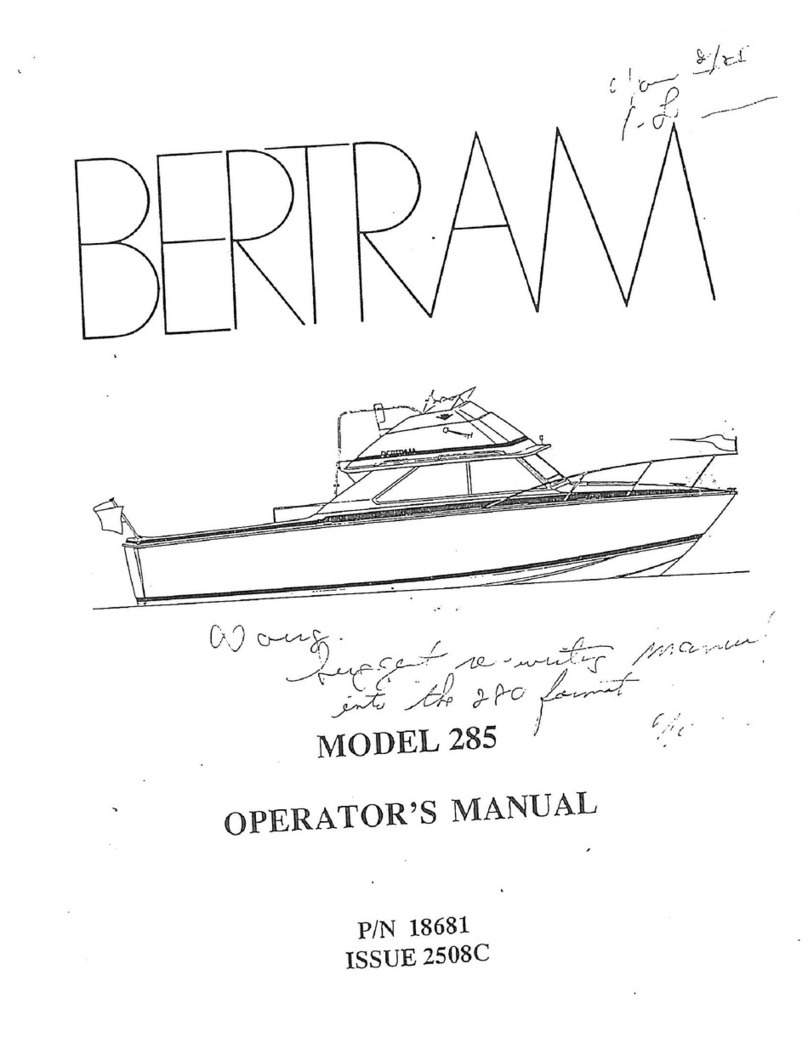
Bertram
Bertram 285 User manual

Bertram
Bertram 390 Convertible User manual
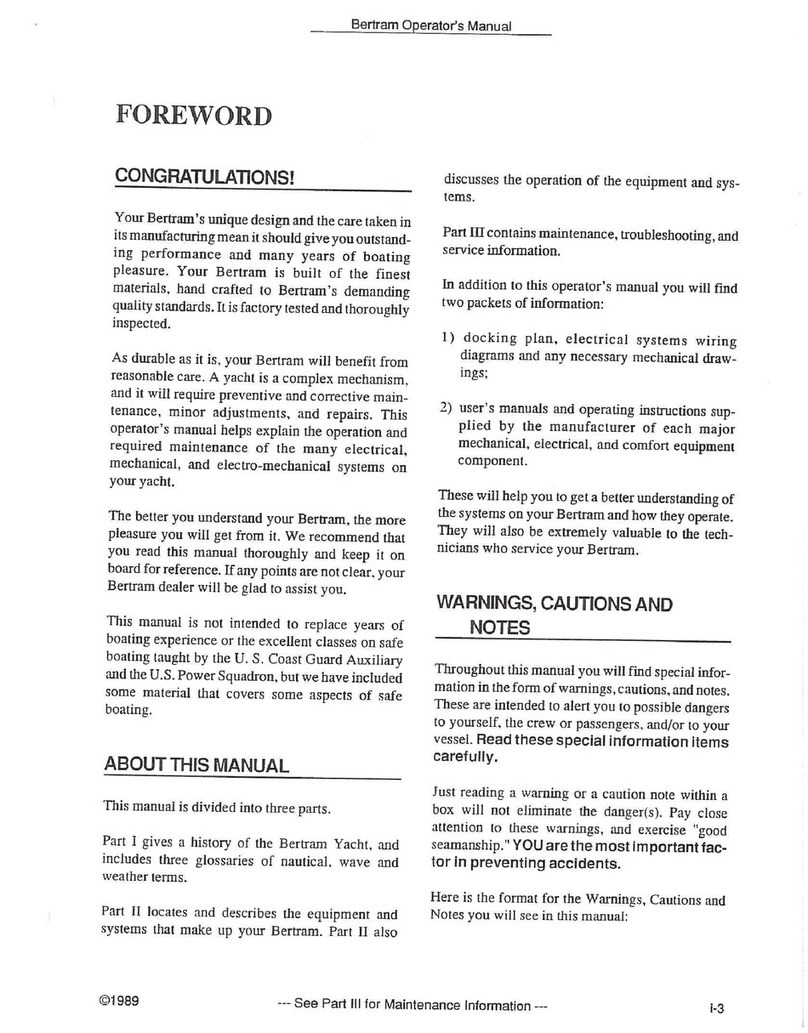
Bertram
Bertram 50 User manual
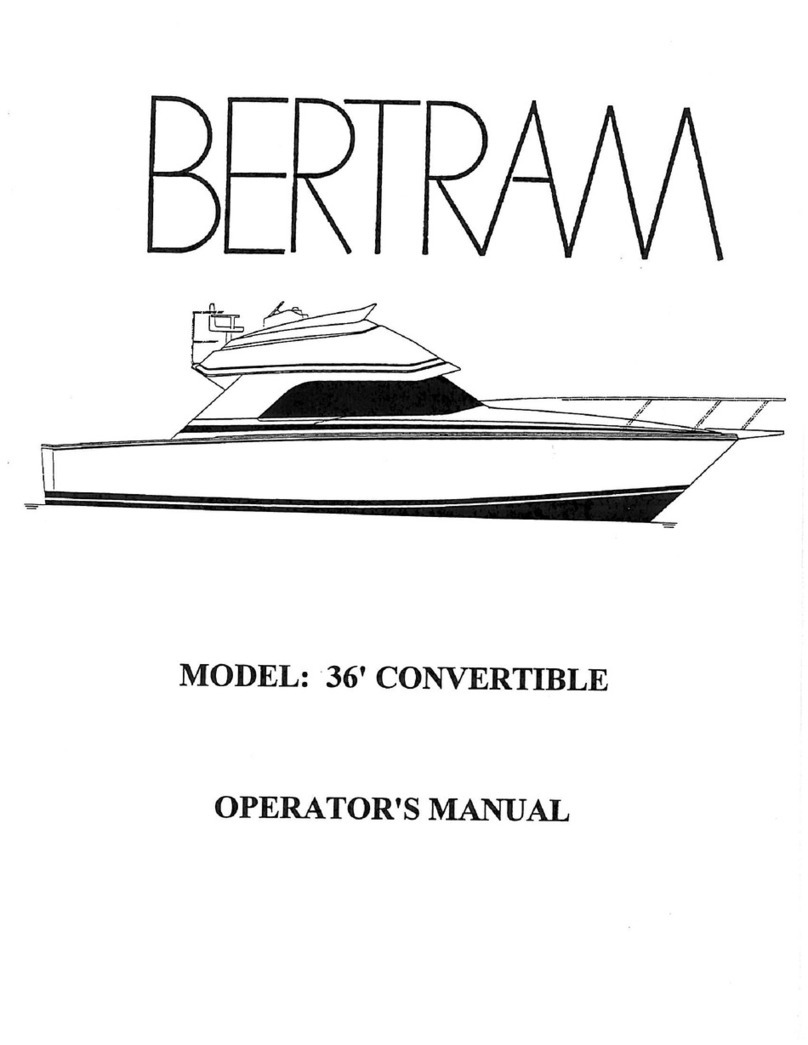
Bertram
Bertram 36" Convertible User manual
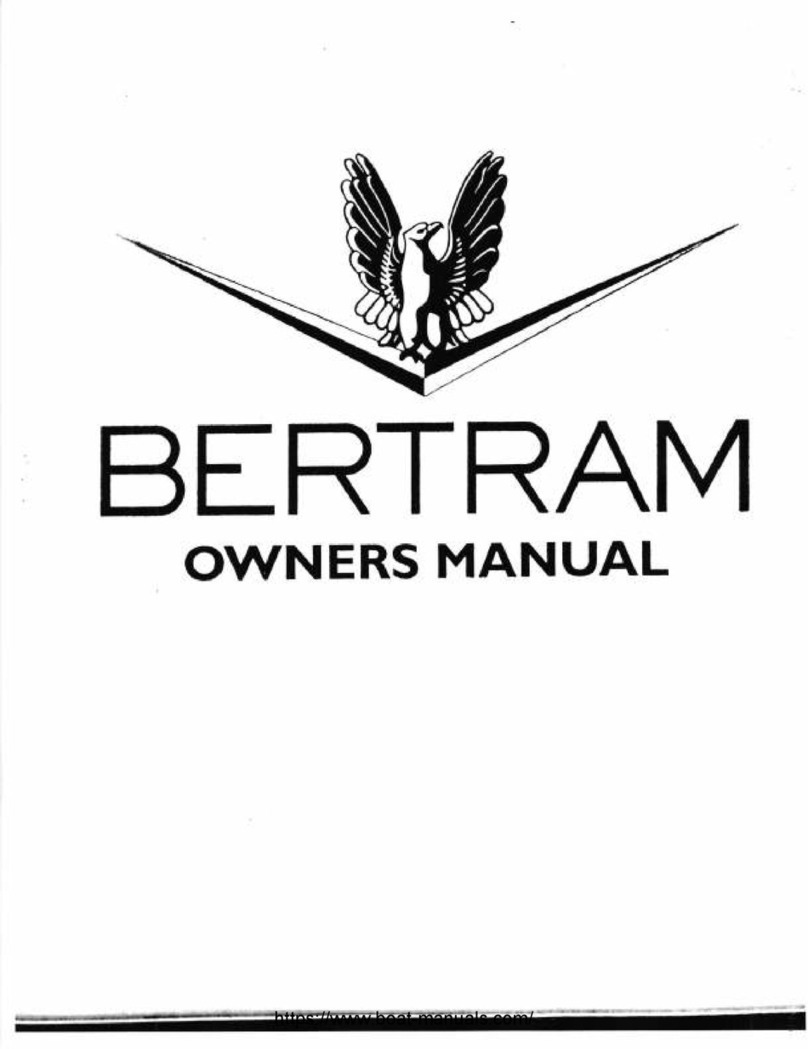
Bertram
Bertram 36' MOPPIE User manual
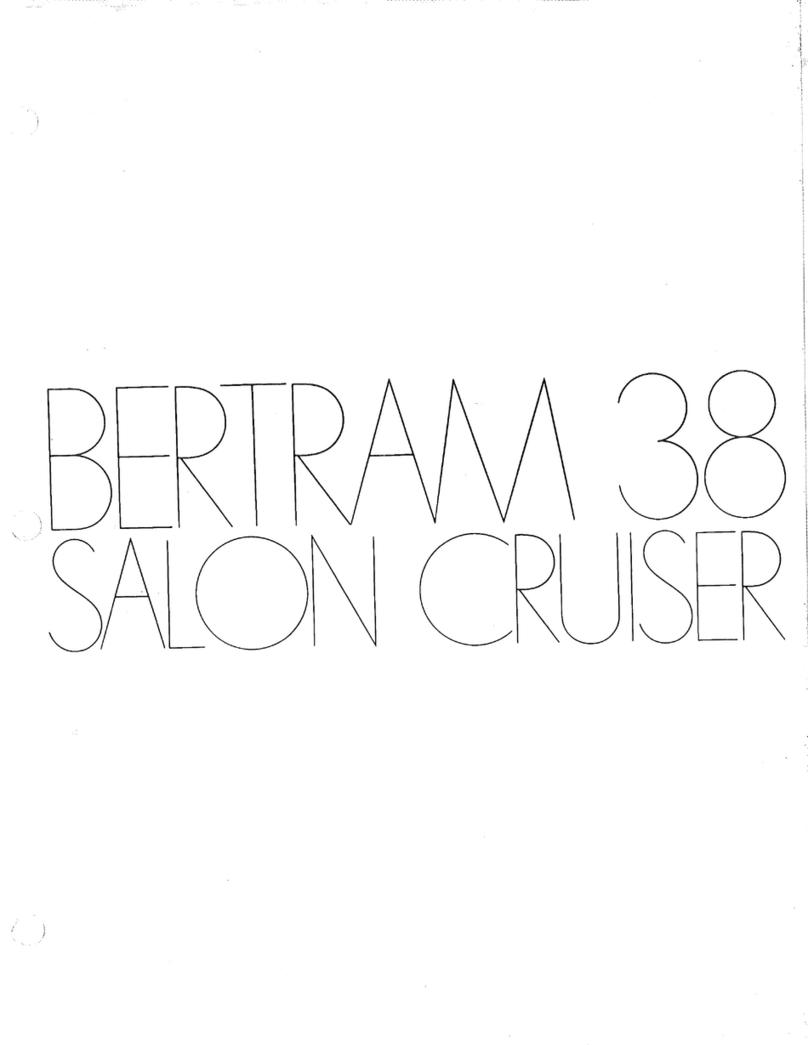
Bertram
Bertram 38 Salon Cruiser User manual
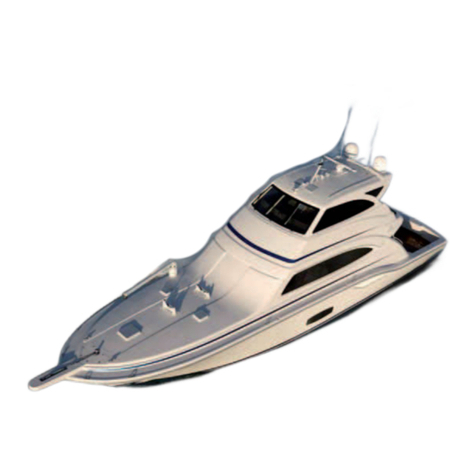
Bertram
Bertram 700 User manual
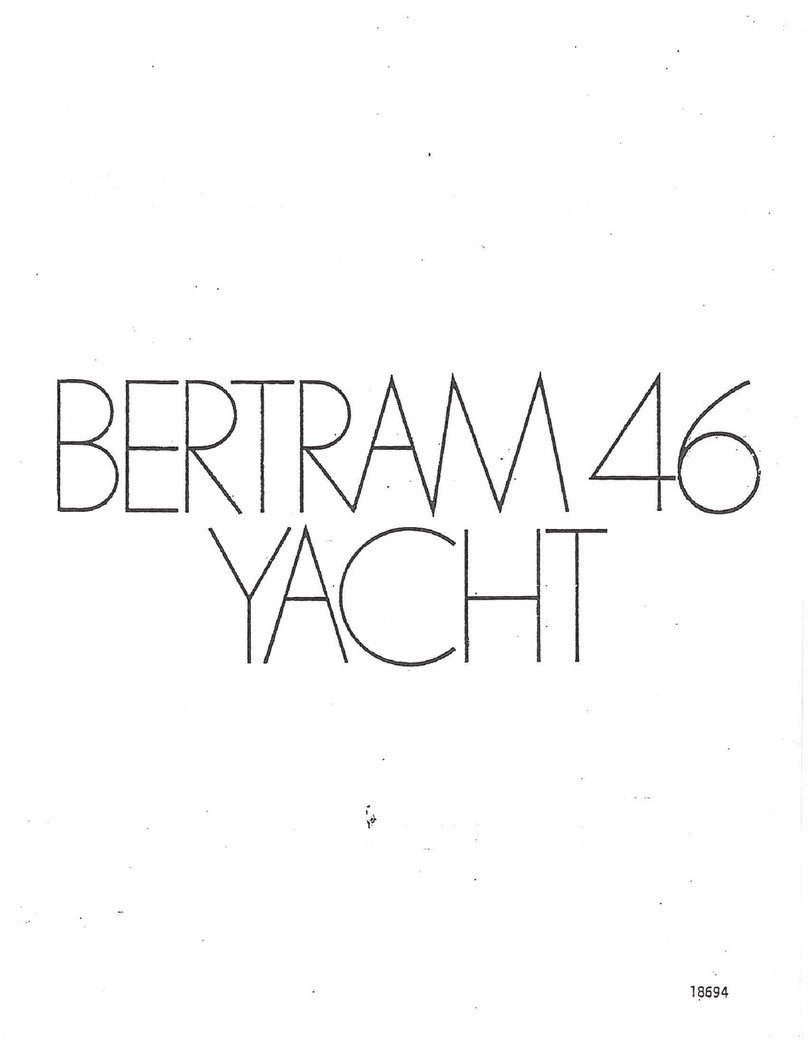
Bertram
Bertram 46 User manual

Bertram
Bertram 670 User manual
